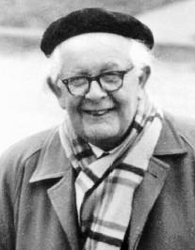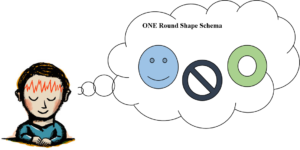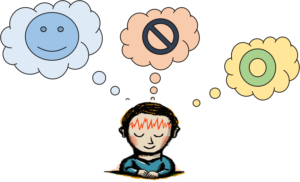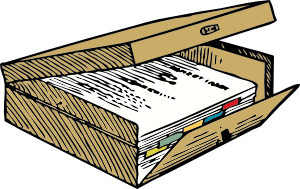 Jean Piaget (1896-1980), a Swiss biologist who later focused on psychology developed his theories of learning based on observation of his own three young children from birth. Being a biologist, Piaget was most interested in the way mollusks (or sea shells) organised and adapted themselves with the surrounding environment which inspired his ideas on learning. He suggested that children learn by fitting new information with their existing knowledge or what children already know. So, children are not empty vessels in which adults pour all kinds of information into their heads. Piaget explained how children learn based on FOUR basic components: Schema, Assimilation, Accommodation and Equilibrium.
Jean Piaget (1896-1980), a Swiss biologist who later focused on psychology developed his theories of learning based on observation of his own three young children from birth. Being a biologist, Piaget was most interested in the way mollusks (or sea shells) organised and adapted themselves with the surrounding environment which inspired his ideas on learning. He suggested that children learn by fitting new information with their existing knowledge or what children already know. So, children are not empty vessels in which adults pour all kinds of information into their heads. Piaget explained how children learn based on FOUR basic components: Schema, Assimilation, Accommodation and Equilibrium.
SCHEMA
Piaget believed that the mind is made up of several schemas. A schema is like a file which contains relevant description of information. For example, a child who has a schema of a cat  will recognise that it has 4 legs, fur, whiskers, tail, 2 eyes, 2 ears and others. Each of these schemas or files are stored in a cabinet in the brain (see picture). When a child is born, it has few schemas or files and as the child grows, he or she gains more schemas.
will recognise that it has 4 legs, fur, whiskers, tail, 2 eyes, 2 ears and others. Each of these schemas or files are stored in a cabinet in the brain (see picture). When a child is born, it has few schemas or files and as the child grows, he or she gains more schemas.
For example, at birth the baby has only ONE schema for sucking which is reflexive in nature. The baby will suck on anything that is put in her mouth because it expects milk from the mother’s  nipple. So, if you put a finger in her mouth, she will suck on it (see picture). The baby is unable to differentiate between a finger or a nipple because it has only a single sucking schema. Slowly, she learns to differentiate between milk-producing objects (such as a nipple) are accepted while non-milk objects are rejected. At this point, the baby has TWO sucking schemas, one for milk-producing objects and one for non-milk producing objects. Interesting ah!
nipple. So, if you put a finger in her mouth, she will suck on it (see picture). The baby is unable to differentiate between a finger or a nipple because it has only a single sucking schema. Slowly, she learns to differentiate between milk-producing objects (such as a nipple) are accepted while non-milk objects are rejected. At this point, the baby has TWO sucking schemas, one for milk-producing objects and one for non-milk producing objects. Interesting ah!
ASSIMILATION
Earlier Piaget said that a child learns by fitting new information with the child’s existing knowledge or what the child already knows. The following is one way how it happens: One is by Assimilation (or absorption), when the child integrates new information or experience into an existing or readily available schema. See diagram. Assimilation occurs all the time because a child is always absorbing various kinds of information and experiences. The existing or readily available schema is like a balloon that gets bigger and bigger with the addition or assimilation or new information and experiences. No new schemas are produced because old schemas are used.

See diagram above which shows a child seeing THREE DIFFERENT ROUND SHAPES. Because the child has ONE existing schema (or file) of round shapes, the three round shapes are fitted into the ONE Round Shape Schema even though they are different. The round shape schema gets bigger and bigger to absorb or assimilate the new information.
ACCOMMODATION
Earlier Piaget said that a child learns by fitting new information with the child’s existing knowledge or what the child already knows. The following is another way how it happens? Sometimes, the child cannot assimilate or absorb new information because he or she does not have an existing schema to fit in the new information. What does the child do? Marvelously, the child creates a NEW SCHEMA. This process is called Accommodation which is the creation of new schemas to fit in new information or experiences.

See diagram above which shows a child shown three different round shapes. Because the child does not have an existing schema of ‘round shapes’, THREE NEW SEPARATE SCHEMAS are created. Smart eh!
EQUILIBRIUM
Imagine what would happens if a child ONLY ASSIMILATES as she gets older. The result would be disastrous. She will have only a few schemas with lots of information in each schema. Like a balloon, will it burst? It is like having only one ‘thick file’ with all the information it it (see picture).
Alternatively, imagine what would happen if the child ONLY ACCOMMODATES as she gets older.  The result would also be disastrous. She will have have many, many schemas with each information in one schema (see picture). Can he brain handle so many separate pieces of information? It is like having many, many ‘thin files’ with small bits of information in each.
The result would also be disastrous. She will have have many, many schemas with each information in one schema (see picture). Can he brain handle so many separate pieces of information? It is like having many, many ‘thin files’ with small bits of information in each.
This is where EQUILIBRIUM comes in. Equilibrium is when the child does not ONLY assimilate or ONLY accommodates but strikes a balance. She creates a balance between assimilation and accommodation. The opposite is DISEQUILIBRIUM.
When disequilibrium occurs, the learner seeks equilibrium; that is, whether to further assimilate or accommodate. Take the example of a children learning about the word ‘furniture’. He is introduced to 4 words such as chair, table, cupboard and sofa. He tries to assimilate all these words into a schema called ‘furniture’ and that is assimilation. Suddenly, he is introduced a fifth word ‘shirt’ which he knows he cannot include it in the ‘furniture’ schema. What does he do? He creates a new schema and that is accommodation. He has successfully achieved equilibrium. In other words, a child who cannot assimilate new information into an existing schema, attempts to accommodate by creating a new schema. Thus, equilibrium is reached. According to Piaget, learning proceeds in this way from birth through adulthood.
Watch these 2 Video Clips explaining what was just discussed
RETURN to Course Description
 Jean Piaget (1896-1980), a Swiss biologist who later focused on psychology developed his theories of learning based on observation of his own three young children from birth. Being a biologist, Piaget was most interested in the way mollusks (or sea shells) organised and adapted themselves with the surrounding environment which inspired his ideas on learning. He suggested that children learn by fitting new information with their existing knowledge or what children already know. So, children are not empty vessels in which adults pour all kinds of information into their heads. Piaget explained how children learn based on FOUR basic components: Schema, Assimilation, Accommodation and Equilibrium.
Jean Piaget (1896-1980), a Swiss biologist who later focused on psychology developed his theories of learning based on observation of his own three young children from birth. Being a biologist, Piaget was most interested in the way mollusks (or sea shells) organised and adapted themselves with the surrounding environment which inspired his ideas on learning. He suggested that children learn by fitting new information with their existing knowledge or what children already know. So, children are not empty vessels in which adults pour all kinds of information into their heads. Piaget explained how children learn based on FOUR basic components: Schema, Assimilation, Accommodation and Equilibrium. will recognise that it has 4 legs, fur, whiskers, tail, 2 eyes, 2 ears and others. Each of these schemas or files are stored in a cabinet in the brain (see picture). When a child is born, it has few schemas or files and as the child grows, he or she gains more schemas.
will recognise that it has 4 legs, fur, whiskers, tail, 2 eyes, 2 ears and others. Each of these schemas or files are stored in a cabinet in the brain (see picture). When a child is born, it has few schemas or files and as the child grows, he or she gains more schemas. nipple. So, if you put a finger in her mouth, she will suck on it (see picture). The baby is unable to differentiate between a finger or a nipple because it has only a single sucking schema. Slowly, she learns to differentiate between milk-producing objects (such as a nipple) are accepted while non-milk objects are rejected. At this point, the baby has TWO sucking schemas, one for milk-producing objects and one for non-milk producing objects. Interesting ah!
nipple. So, if you put a finger in her mouth, she will suck on it (see picture). The baby is unable to differentiate between a finger or a nipple because it has only a single sucking schema. Slowly, she learns to differentiate between milk-producing objects (such as a nipple) are accepted while non-milk objects are rejected. At this point, the baby has TWO sucking schemas, one for milk-producing objects and one for non-milk producing objects. Interesting ah!  The result would also be disastrous. She will have have many, many schemas with each information in one schema (see picture). Can he brain handle so many separate pieces of information? It is like having many, many ‘thin files’ with small bits of information in each.
The result would also be disastrous. She will have have many, many schemas with each information in one schema (see picture). Can he brain handle so many separate pieces of information? It is like having many, many ‘thin files’ with small bits of information in each.




